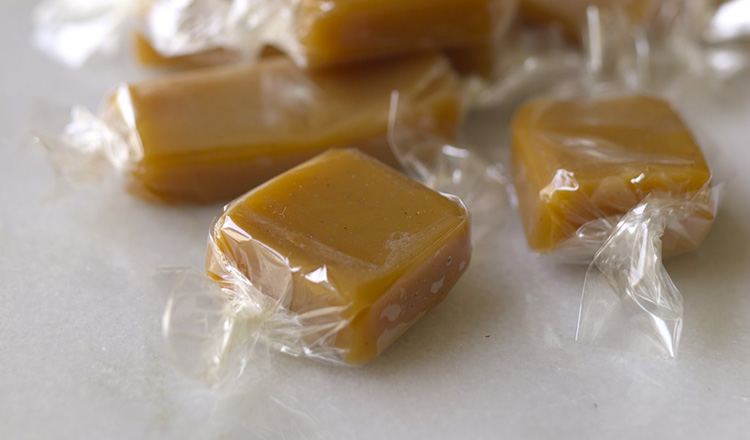
Caramels are among the most popular of all confections, and in any box of assorted chocolates they are very likely to be the first to disappear. The name caramels is not entirely accurate, as the brown color and roasted flavor are not at all due to the caramelization of sugar, but to the browning of the milk solids contained in them (known as the Maillard reaction).
What’s in caramel candies?
– Sugar provides sweetness and bulk to the candy.
– The purpose of corn syrup is to prevent the re-crystallization of the sugar and to contribute to the chewy texture of the candy. Soft caramels normally contain a high proportion of corn syrup, nearly equal to that of sugar.
– While fresh dairy products such as milk or cream may be used in caramels, processed dairy products such as evaporated milk or sweetened condensed milk are more common due to their lower water content and their greatly reduced cooking time. Regardless of the dairy product used, it provides the milk solids that give caramels their characteristic color and flavor, and it helps the candy hold its shape when being cut after it is cooked.
– Butter provides flavor and a shorter texture to caramels.
– Salt is an optional ingredient; it can be added to improve the flavor of the candy. Vanilla extract and salt are the most common flavors added to caramels, but other flavoring agents such as extracts, fruit purees, or spices may also be added.
Caramels are fundamentally simple to make; sugars and dairy products are cooked to remove water and develop color and flavor, while being stirred constantly to prevent scorching. The most crucial step in cooking soft caramels is the temperature to which they are cooked: Undercooking leads to very soft candies; overcooking results in caramels that are too hard to comfortably bite.
Almost without exception, soft caramels are poured into a pan or frame and allowed to cool. Once cooled, they can be cut with a knife.
Soft caramels are susceptible to damage from moisture, so they must be protected from humidity. Cut caramels should either be individually wrapped immediately or else dipped in chocolate to insulate them from moisture.
Soft Caramels
Makes one 9-in x 13-in slab
- 4 oz (1/2 cup) water
- 1 lb (2 cups) sugar
- 1 vanilla bean, split and seeds scraped
- 1 can (14 oz) sweetened condensed milk
- 12 oz (1 cup) light corn syrup
- 6 oz (12 tbsp, 1½ sticks) unsalted butter, soft
- 1 tsp salt
1. Lightly butter a 9 × 13–inch baking pan and prepare a small bowl of ice water.
2. Combine the water, sugar, vanilla bean, condensed milk, corn syrup, and butter in a heavy-bottomed 4-quart saucepan. Bring to a boil, stirring constantly with a heat-resistant rubber spatula.
3. Continue stirring while cooking until the batch reaches 245°F. This is a good estimation of the required temperature. When the thermometer reads 240°F, dip a spoon into the caramel and then dip the spoon into the ice water. The cooled piece on the spoon should be fi rm but not hard when the caramel is properly cooked.
4. Remove from the heat and stir in the salt. Pour into the prepared pan and remove the vanilla bean using a fork.
5. Allow to cool completely to room temperature, at least 2 hours.
6. Remove the sheet of caramels from the pan. Cut into the desired size pieces using a sharp chef’s knife.
7. The pieces may be dipped in tempered chocolate or compound coating, or may be wrapped individually in cellophane or waxed paper if they are not going to be used within a day or two.
Variations:
CARAMELS WITH NUTS: Mix 2 1/2 cups chopped toasted nuts into the caramels after they are cooked but before pouring them into the pan.
CHOCOLATE CARAMELS: Add 6 oz/1 cup chopped dark chocolate to the mixture at the beginning of cooking.
COFFEE CARAMELS: Add 1 tbsp instant coffee granules to the mixture at the beginning of cooking.
FRUIT CARAMELS: 1 cup fruit puree (raspberry, mango, and apricot work nicely) to the batch when it reaches 240°F. Continue cooking to 245°F.
SPICE CARAMELS : Add 2 tsp of desired ground spice (such as cinnamon, anise, or ginger) to the batch at the beginning of cooking.
